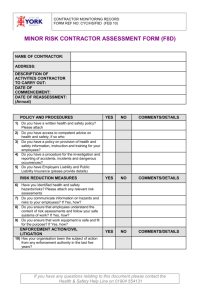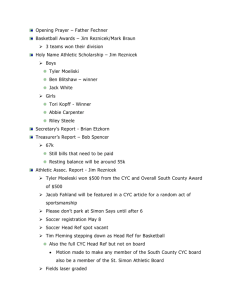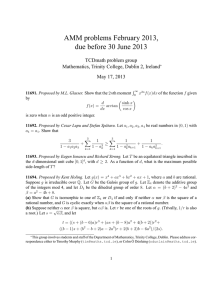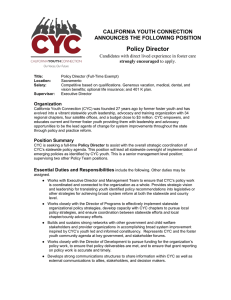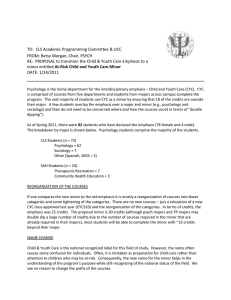PUTTING FLESH ON THE BONES: ... CREATING ANATOMICAL KNOWLEDGE BASES
advertisement
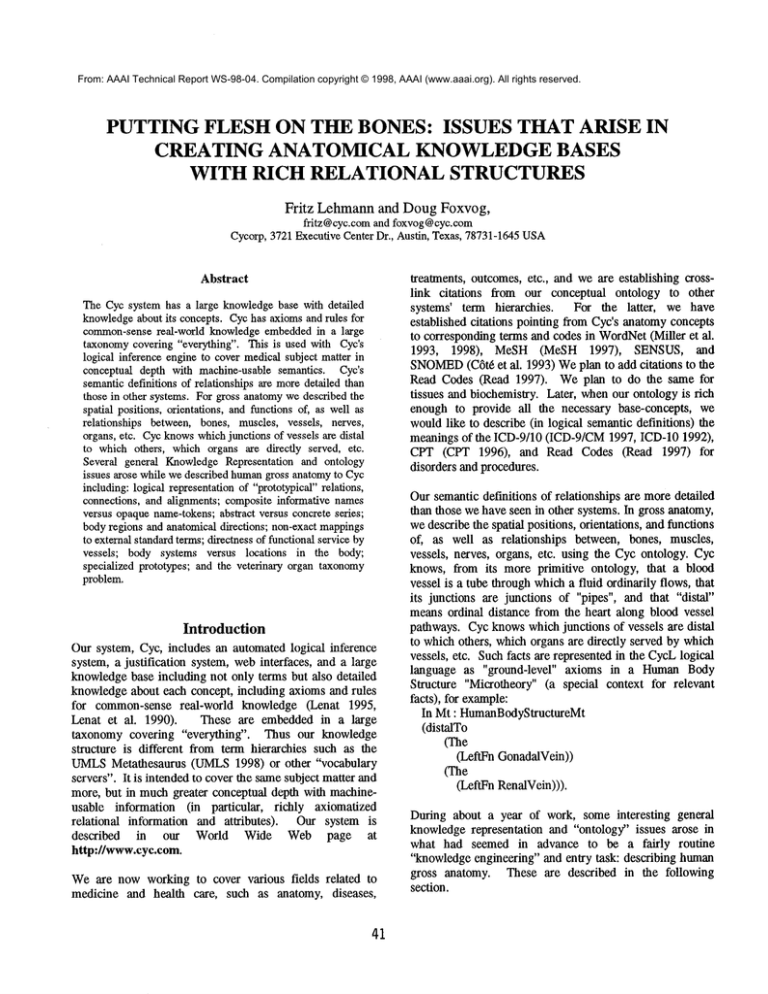
From: AAAI Technical Report WS-98-04. Compilation copyright © 1998, AAAI (www.aaai.org). All rights reserved. PUTTING FLESH ON THE BONES: ISSUES THAT ARISE IN CREATING ANATOMICAL KNOWLEDGE BASES WITH RICH RELATIONAL STRUCTURES Fritz Lehmann and Doug Foxvog, fritz@cyc.comand foxvog@cyc.com Cycorp,3721ExecutiveCenter Dr., Austin, Texas, 78731-1645 USA Abstract The Cycsystem has a large knowledgebase with detailed knowledge about its concepts. Cychas axiomsand rules for common-sensereal-world knowledgeembeddedin a large taxonomycovering "everything". This is used with Cyc’s logical inference engine to cover medicalsubject matter in conceptual depth with machine-usable semantics. Cyc’s semanticdefinitions of relationships are moredetailed than those in other systems.For gross anatomywedescribed the spatial positions, orientations, andfunctionsof, as well as relationships between, bones, muscles, vessels, nerves, organs, etc. Cycknowswhichjunctions of vessels are distal to whichothers, whichorgans are directly served, etc. Several general KnowledgeRepresentation and ontology issues arose while wedescribed humangross anatomyto Cyc including:logical representationof "prototypical"relations, connections, and alignments; compositeinformative names versus opaquename-tokens;abstract versus concreteseries; bodyregions and anatomicaldirections; non-exactmappings to externalstandardterms;directnessof functionalservice by vessels; body systems versus locations in the body; specialized prototypes; and the veterinary organtaxonomy problem. Introduction Our system, Cyc, includes an automated logical inference system, a justification system, webinterfaces, and a large knowledgebase including not only terms but also detailed knowledgeabout each concept, including axioms and rules for common-sense real-world knowledge (Lenat 1995, Lenat et al. 1990). These are embedded in a large taxonomy covering "everything". Thus our knowledge structure is different from term hierarchies such as the UMLSMetathesaurus (UMLS1998) or other "vocabulary servers". It is intended to cover the samesubject matter and more, but in muchgreater conceptual depth with machineusable information (in particular, richly axiomatized relational information and attributes). Our system is described in our World Wide Web page at bttp://www.cyc.com. Weare now working to cover various fields related to medicine and health care, such as anatomy, diseases, 41 trealments, outcomes,etc., and we are establishing crosslink citations from our conceptual ontology to other systems’ term hierarchies. For the latter, we have established citations pointing from Cyc’s anatomyconcepts to corresponding terms and codes in WordNet(Miller et al. 1993, 1998), MeSH (MESH 1997), SENSUS, SNOMED (C6t6 et al. 1993) Weplan to add citations to the Read Codes (Read 1997). Weplan to do the same for tissues and biochemistry. Later, whenour ontology is rich enough to provide all the necessary base-concepts, we wouldlike to describe (in logical semantic definitions) the meanings of the ICD-9/10 (ICD-9/CM1997, ICD-10 1992), CPT (CPT 1996), and Read Codes (Read 1997) disorders and procedures. Our semantic definitions of relationships are moredetailed than those we have seen in other systems. In gross anatomy, wedescribe the spatial positions, orientations, and functions of, as well as relationships between, bones, muscles, vessels, nerves, organs, etc. using the Cyc ontology. Cyc knows, from its more primitive ontology, that a blood vessel is a tube through whicha fluid ordinarily flows, that its junctions are junctions of "pipes", and that "distal" means ordinal distance from the heart along blood vessel pathways. Cyc knowswhich junctions of vessels are distal to which others, which organs are directly served by which vessels, etc. Suchfacts are represented in the CycLlogical language as "ground-level" axioms in a Human Body Structure "Microtheory" (a special context for relevant facts), for example: In Mt : HumanBodyStructureMt (distalTo (The (LeftFn GonadalVein)) (The (LeftFn RenalVein))). During about a year of work, some interesting general knowledgerepresentation and "ontology" issues arose in what had seemed in advance to be a fairly routine "knowledgeengineering" and entry task: describing haman gross anatomy. These are described in the following section. Semantic Issues Issue 1. Logical Representation of Prototypical Relations Straightforward logical representation of bodypart relations is too burdensome. In English, we say "the heart" is connected to "the aorta", but in a logical description of reality it is individual hearts that are connectedto individual aortas. If we formalize the general rule in logic, using the notation (predicate argumentl argument2argument3...) and (connective propositionl proposition2 proposition3 ...), as: ForAll h,v: (implies (and (instanceOf h Hear0 (instanceOf v Vertebrate) (anatomicalParts v h)) (thereExists (and (instanceOf a Aorta) (anatomicalParts v a) (connectedToa h)))) [=>] We put prototype-related statements in a special BodyStructure "microtheory" or context called "VertebrateBodyStructureMt"as follows: In Vet tebrateBodyStructureMt: (eonnectedTo(The Heart) (The Aorta)). [h is part of v] [such that] which is a muchsimpler statement: in the "prototypical vertebrate", "The Heart" and "The Aorta" are connected. (Actually the connection used is more specific than connectedTo--- see below.) some of the meaning of the rule is expressed, but not enough. The above says that for every individual heart of a vertebrate, somethingexists which is an aorta in that vertebrate and is connectedto that heart. Unfortunately that still allows the heart to be connectedto several aortas, and fails to say that for every aorta there exists exactly one heart connected to it. Manyre-formulated logical fixes of this problemlead to their ownlogical problems: Va 3h Instead, we use a "prototype" individual, the "typical person" individual, and use a functional "The" to denote "The Heart", "The Liver", "The Aorta", of that person, etc. This works only for unique body parts: (The Heart). For paired parts we use (The (LeftFn Lung)) where "LeftFn" a function returning the leftmost of two bilaterally symmetricalbody parts. This will not workfor multifarious bodyparts like alveoli, hairs, etc. Parts of a paired body part that themselves have no symmetriccounterpart, such as the middlelobe of the right lung, are unique bodyparts and are referred to accordingly. (The left lung has no middle lobe.) In our work on prototypes, we allow for exceptions. The reason that anatomicalprototypes workat all is that people tend to be "cut from the same pattern." Downto a certain level of detail, they have most internal part properties and relations in common.But the Cyc system recognizes that in certain respects an individual maydepart seriously from the "normal" anatomical pattern. Prototypical body parts are mapped to an individual’s particular body parts using BodyPartFn for unique body parts and BodyPartCollectionFnfor multiferous parts. Cyc only has to be told: a (alignedAlongLength (The (LeftFn RadialArtery)) (The (LeftFn Radius-Bone))), a’ meaning"the left radial artery is aligned along the left radius", to knowthat Ann’s left radial artery is aligned along her radius: In the diagramabove, a heart has an aorta, and an aorta has a heart, etc., but the quantified formulae fail to makesure that the heart of the aorta of the original heart is the same heart. Moreover, even if it is done completely correctly, the resulting formula is too long and complicatedfor people to read, or to be used efficiently in machineinference. 42 (alignedAlongLength (BodyPartFn Ann(LeftFn RadialArtery)) (BodyPartFn Ann (LeftFn Radius-Bone))). one or more rules detailing express to the reader. Issue 2. Connections and Alignments In stating the connections and alignments betweenparts, we have specialized the concept for "physically connected" into dozens of more informative connection predicates. The connection predicates (relations) say howthe two items are connected. Wehave supplied logical definitions (for these connection relations) that are used in logical machine inference. The connection relations form a subsumption hierarchy of relations, having connectedToat the top (most general) with more specific connection relations below it. There are several "dimensions" to this specificity. The rigidity of the connection, the degrees of freedom,the forms of the related objects (like cavity, vessel, fiber), the relative spatial alignment (along, inserted into, wrapped around, etc.), and whether fluid can flow between the items, are amongthe manyways of specializing "connectedTo". Two pipes may be aligned with each other in several possible spatial relations. Similarly, a cylinder can be alongside a sheet or membrane in several different ways. In most cases the two items may be either connected or merely juxtaposed. There may be specific connectiontypes such as synovial, grafted, sutured, or even stapled. Wehave predicates for the various juxtapositions, and for the various corresponding connection types in which the so-juxtaposed body parts are connected. The following is a list of some of the anatomy-relevant connection types, excluding things like screwedln needed for other domains (although some prostheses are screwed into bone) and mere juxtaposition types. Morecomplicated connection types that include extra parameters are also excluded from this list. Eachof these connection types has 43 what the name is meant to connectedTo conn ectedAtCon tact adjacentPathsAtJunction cavityConnectedAlongPathSide connectedAlongEdge connected-EdgeToEdge connected-EdgeToEdge-Acute connected-EdgeToSurface connected-EdgeAlongCylinder connected-SheetTransectsAlong connected-EntireEdge connectedAlongSurface sheetSurfaceConnected connectedAtEnd connected-AbutsSurface pipeAbuts-DeadEnd endToEndConnected pipeEndsAtCavity connectedAtSpot cavityConnectedAlongPathSide connected-LengthAlongSurface in-Embedded embeddedCylinderlnSheet in-l_xxlged musclelnsertion muscleOrigin conn ectedAlongin side connectedAlongLength connectedAlongAlignedLengths connectedAround stuckTo connectedViaConnector connectedTo-Rigidly rotationaUyConnectedTo connectedTo-S emiRigidly connectedViaFlexibleConnector flapHingedTo connectedTolnside directlyServesB odyParts innervates musclelnsertion muscleOrigin The indenting in the list shownabove does not reflect the full hierarchy of connectiontypes. Evenafter the irrelevant relations wereedited out; duplicates in the indentedlist, due to being under multiple parent relations, were removed. This subsumptionrelation betweenrelations is used directly for machineinference. For example, the aorta - heart connection has actually been asserted as (pipeEndsAtCavity (The AscendingAorta) (The (LeftFn VentficleOfHear0)). Instead, in many cases we followed medical practice in using composite, informative functional designators rather than simple names: This implies the aforementioned (connectedTo (The Heart) (The Aorta)) because (The (LeftFn VentricleOfHear0) part of (The Hear0, (The AscendingAorta)is a part of (The Aorta), (The Heart) and (The Aorta) are disjoint, predicate connectedTo subsumes the predicate pipeEndsAtCavity, and the predicate connectedTo is a symmetric predicate (i.e. (connectedTo X Y) implies (connectedToY X)). Cyc knowsall this automatically. To express the connection between the Mesentery sheet and the Small Intestine we write: (connected-EdgeAlongCylinder (The Mesentery) (The Smalllntestine)): (Nth (The (LeftFn FingerSeries)) meansthe fourth digit of the left-hand finger series counting laterally from the thumb. The compositedescription with nested functions allows the Cyc program to draw various fairly general inferences automatically. Cyc knowsthat the above exampleis part of the left hand, is betweenthe third and fifth digits, that it is connected synovially to the fourth metacarpal bone by the fourth metacarpal joint, etc., without having explicit statementsof all such facts Issue 4. Abstract Versus Concrete Series To express the connection between the Tectorial Membrane and the Cochlear Tubein the Inner Ear we write: (connected-SheetTransectsAlong (The (LeftFn TectorialMembrane)) (The (LeftFn CochlearTube))): Issue 3. Composite Informative Opaque Names Names Versus Wecould have created all anatomy concepts with long single names, possibly helpful to humanbeings, but not to computers, like FourthDigitOtLeftHand or, equally good for the machine, Qx5897xypvtd15a. 44 Representing parts of the body that are deemedto be in a series, or customarily are counted, forced us to face the deep issue of an abstract structure versus its real-world embodiments. The vertebrae, for example, are in several series and we customarily count from the cephalic end of such a series to designate a particular vertebra. I Wehave, in Cyc, axiomsabout sequences as abstract entities -- that there may be a first and a last, that no element has two immediate successors or two immediate predecessors, the notion of "betweenness", and so on. We’d like these features to apply to the real-world series, such as the vertebraein situ. Weconsidered two ways to accomplish this: Approach 1. Treat real-world structures as specializations of general abstract structures. Assert that every real-world embodimentof an abstract structure is an instance of the general (including the abstract) collection such structures. In this view, any triangular pretzel is a triangle. This makesevery defined collection of real-world series (such as the collection of all series of vertebrae, or the collection of all rows of teeth, or the collection of all series of dorsal rami) a subset of the collection of all series. A drawbackof this approach is that Cyc cannot efficiently concludethat two isomorphic(structurally identical) series are "the same", even in the very abstract domains (like mathematicalGraphTheory) in which this is desirable. 1 The ordering is purely conventional, and often depends on the culture. In English, the fingers are countedfrom the thumbto the little finger, whereasin Burushaskithey are countedfrom the little finger to the thumb(the 5th finger). I Series Werecognize the formal merits of Approach2, but for the reasons of not wanting to duplicate axioms, and not wanting to map back and forth across the "embodiedBy" links during reasoning, we have stayed with Approach1 so far, for pragmatic convenience. I ~~subclass Abstract List I Spine I This structural issue will be also be important when we represent genetic structures like nucleic acid sequencesand aminoacid sequences. I Spine#3301 Approach2. Treat real-world structures and abstract structures as separate but corresponding systems. Assert that for every structured real-world thing, there is a corresponding abstract structure that it "embodies". In this view, any triangular pretzel is not a triangle, but it has a corresponding abstract structure which is a triangle. Abstract objects within the abstract structure have corresponding real objects in the real-world thing, and, similarly, abstract relations amongabstract objects have corresponding real relations amongthe real objects. For example, the "succession" relation between the Nth and N+lst item in an abstract list of vertebrae corresponds to the actual joint betweena vertebra and the vertebra below it. This is the more"pure and correct" approach, but it has the drawbackthat either a.) all the axiomsfor, say, series have to occur in the Knowledgebase twice, once for the abstract and once for the real, or b.) to concludesomething (like betweenness)for real objects, Cychas to mapto the abstract domain, deduce the relations, and reverse-map back to the real objects. Both solutions are very burdensome. Approach2 has a so-called "commutingsquare": REAL WORLD ABSTRACT STRUCTURE Listltem followedBy ListItem embodiedB y ), Vertebra I embodiedBy ), IntervertebralJoint embodiedBy Issue 5. Body Regions and Directions Various anatomical "directions" including distal, proximal, ventral, dorsal, lateral, and caudal, have been defined. Originally we considered mappingthese to our pre-existing "up" and "down" based predicates, but this could not be done. "Distal" does not really mean "distant from". It means "more distant along a certain type of path". For the cardiovascular system, it is distance along vessels (primarily veins & arteries) from the heart. The aorta goes up from the heart at first, to the left, and then down; nonetheless, all junctions in the aortic arch, and in the rest of the aorta, are distal to the aortic valve. There are two overlapping body region/direction systems commonlyused - one related to body structure (caudalcephalic, ventral-dorsal .... ) and the other related to orientation with respect to the external world, assumingthat the animal is in "standard position" (superior-inferior, posterior-anterior). In hamanbeings, with an erect spine assumed, the mappingbetween the two systems in the body is different than that for most other vertebrates, which normally have a relatively horizontal spine. However,in the head the mappings are the same. Cyc assertions are written with respect to bodystructure (so that the assertions are not restricted to haman beings), but the system can answerquestions posed in either modality. Certain anatomicaldirections (palmar, plantar, lingual .... apply only with respect to certain body parts (hand, foot, teeth .... ) or have different meanings when used with specific bodyparts (e.g., dorsal in the foot), so Cycrestricts or modifies their meaningsappropriately. ), Vertebra If the top and bottom embodiments hold, and the top Listltem is followedBythe bottom one, then there must be an intervertebral joint betweenthe vertebrae. Now,on the abstract side, two structurally isomorphic structures are deemed "the same thing" whereas on the real-world side two structurally isomorphic structures remain two separate individuals. 45 Weuse body direction terminology for two related sets of concepts: relative directions betweenbodyparts and regions of individual body parts. Whenwe consider the relative directions between body parts, we note that common terminology would allow two ways of making every statement; e.g. (dorsalTo (The ThoracicVertebrae) (The Hear0) (ventralTo (The Hear0 (The ThoracicVertebrae)). SNOMED-Information 1996 "T-01530 Eyelashes") To obviate the need for duplicate assertions, we maintain only one predicate from each inverse pair. When specifying regions however, both region functions (e.g. DorsalRegionFn and VentralRegionFn) are necessary and provided.. Thus both (DorsalRegionFn (The Spleen)) (VentralRegionFn(The Spleen)) exist in the system. Wecreated an elaborate system of Paths, Traversals, and Trajectories to represent the relations between various segments and junctions of vessels. There are some predicates (relations) for which an existing path system must specified as part of every assertion or query, whereas other predicates assume the existence of a conventional, unspecified path system. Predicates like "betweenOnPath" work for all path types. "betweenOnPath"is used to define "distalToFrom" (a ternary predicate specifying the reference organ to be measuredfrom), which is used in turn to define "distalTo" (a binary predicate that assumes standard core organ for a given path type). Thus "distalTo" for the bronchi means something very different from "distalTo" for the arteries. Issue 6. Non-exact Citations to Terms of External Standards In mapping Cyc medical concepts to concepts in cited external standards and thesauri like WordNet, MESH, SNOMED, etc., we found that only sometimes is there a direct one-to-one mappingto cite. For this kind of exact citation we use the ternary predicate: (synonymousExternalConcept CYC-CONCEPT EXTERNAL-SYSTEM-NAME STRING) The more interesting case is when there is some transformation necessary betweenthe meaningof the string in the cited external system and some concept (or some complexexpression madeof concepts) in Cyc. For this we use MeaninglnSystemFn,a function that takes the name of a cited external systemand the cited string in that system, and return as the value whatever (abstract) ’~aeaning" the cited string has in that system. For a simple example: (implies ( (MeaninglnSystemFn SENSUS-Information1997 "LESS-THAN-COMPAR/SON") ?X ?Y) (greaterThan ?Y ?X)). This says that what SENSUSmeans by "LESS-THANCOMPARISON" (for any X and Y) implies the superficially different assertion in Cyc: (greaterThan ?Y ?X), which has its arguments reversed. Cyc does not maintain inverse versions of a relation; instead it just reverses the order of argumentswhennecessary. Similarly, this function can be used when the corresponding term is more general or more specific than the term in question: (genls VisceralPleura (MeaninglnSystemFn MeSH-Information1997 "pleura I A4.716")) where "genls " means generalizations. Thus the Cyc concept VisceralPleura has as a generalization whatever MeSHmeans by string "pleura I A4.716". as in, for example: (synonymousExternalConcept Cerebrum MeSH-Information1997 "Telencephalon I A8.186.211.730.885"). In our web-based interface, clicking the mouse-button on "MeSH-Information1997" yields a fuller bibliographic citation. Wherethe citation to MesHis only approximate, but close, we use ovedappingExternalConceptin the same way: (overlappingExtemalConcept Eyelash 46 Another way to link Cyc concepts to terms in external systems, beyondsimply citing the relevant parts, is to use Cycorp’s Multi-Thesaurus Correlator/Manager product. This is software that managesan unlimited numberof large thesauri simultaneously, with an unlimited number of relation types, output filters, integrity constraints, etc. Our "correlator" automatically suggests candidate terms for correlation of a term in one thesaurus to preferred terms in another thesaurus. It uses the underlying Cyc ontology to suggest candidate terms based on semantic meaningrather than just word-resemblance. The enormous work of integrating two large thesauri properly is drastically cut, since the user does not have to hunt aroundaimlessly trying to find the best "matchingterm" (if there is one at all). loaded a combination of the UMLS Metathesaurus and the Semantic Network into our Multi-Thesaurus Correlator/Manager to demonstrate that it could handle large thesauri with complicatedstructures. Issue 7. Directness of functional service Cyc’s anatomy project "directlyS ervesBodyPar ts". Body Body systems are a commonway of classifying body parts, as whenan artery is said to be part of the cardiovascular system. Most body parts are ascribable to some system, although there are some, like the spleen, greater omentum, or pituitary, for which several or no systems may be appropriate. developed the predicate The need for the "directly" is that too manyparts depend indirectly on too many others. For example the spleen dependson the aorta for blood, but it moredirectly depends on the splenic artery. Arguably all parts depend on the heart, liver, or brain. As you movein the distal direction along somenerve, artery, vein or bronchus, you find that the area served is smaller and smaller. This applies generically at several levels, to several bodysystems. Generic Supply Lines Issue 8. Body Systems Versus Locations in the Generic Organ A completely separate wayof classifying parts is by their gross physical location. Bodysystems overlay and spatially intersect the system of bodyregions, like the left forearm, the thorax, the neck, the head, etc. Almostevery organ or bone will have positions in both. Issue 9. Specialized Prototypes and the Veterinary Taxonomy Problem Using the "prototype" approach as described in Issue 1, we had to create a prototypical creature with certain bodyparts. Someparts are commonto more than just humanbeings, and occur in other species, other classes, phyla, etc. It was tempting, but practically quite burdensome, to make a prototype for every biological taxonomiclevel. Wesettled on the following three simplified Microtheory (Mt) levels for medical purposes: VertebratePhysiologyMt and VertebrateBodyStructureMtcontain facts true of almost all vertebrates. HumanPhysiologyMt and HumanBodyStructureMtcontain facts true of almost all normal mature humanbeings. The final specialization is by sex. MaleHumanBodyStructureMt and FemaleHumanBodyStructureMtdeal with gender-linked body parts of the prototypical manand woman,respectively. A Here line A directlyServes the whole organ, line C directlyServes the lower portion, and line E directlyServes only one particular lobe. A test would be: "Whatpart is immediatelyaffected if the line is severed?" Cyc considers the most fine-grained nerve/artery/vein/ lymphduct/.., defined in the system to "directlyServe" a given body part. If and when more detailed work is done on a given region of the body, the directlyServes assertions maybe modified and made more specific. 47 Wechose not to use every taxon above homo sapiens to create a new structure mierotheory for the individuals in that taxon. Weavoided creating prototype microtheories for Hominid, Primate, Mammal,Chordate, and Animal. For the time being, if we want to note that a typical snake has one lung, we state that as an exception to the rule that vertebrates have two lungs rather than creating a whole Microtheory for snake anatomical structure. [Fish and immature amphibians are exceptions that have no lungs.] Wedo not have human characteristics spread out among Family, Order, Class, Phylum, etc. taxon Microtheories. In theory we could assign each bodily feature to the most general taxon in which it is common.Wewould do this if we were to tackle general zoological anatomyin depth. Related Work We are aware of several medical vocabulary-servers, thesauri, and taxonomies. The UMLSMetathesaurus (UMLS 1998), SNOMED(C6t6 1993), MeSH (MESH 1997), Read Codes (Read 1997) , NANDA(NANDA 1994), the VA Clinical Lexicon (DVA1994), ICD-9/10 (ICD-9 1997, ICD-10 1992), ICIDH-2 (ICIDH 1998), (CPT 1996), and the Alcohol and Other Drugs Thesaurus (AODT1993) are systems that have some hierarchical structure of medical terms, either explicitly or implicitly in the syntax of assigned codes. The medical parts of more general works like Wilkins’ An Essay Toward A Real Character and Philosophical Language (Wilkins 1668), Roget’s Thesaurus (Roget 1852-1995), WordMenu(Glazier 1992), WordNet (Miller et al., 1993-1998) and Macquarie Thesaurus (Bernard 1986) have similar structures. A taxonomyof terms (especially if it is strictly enforced ,that a child-node is a genuine subclass of its parentnode(s)) forms what we call the "bones" of a medical ontology. The flesh would be the information stored on each term, including ground facts, relation to other terms, rules, axioms, formal logical definitions and constraints. In fact, though, the systems just listed are not strict in requiring that a child-term represents a true subclass of the parent term(s); often the relation is merely a vague "Narrower Term"(NT) relation, (as is used in Information Science thesauri), and the actual relation mayreally be subclass, sub-part, sub-region, tools used, typical participants, typical causes and effects, symptoms,etc. Although the GALEN system (Rector et al. 1994, GALEN 1998) includes a terminology server, it is more than just "bones" in that it aims to include definitional information for its concepts. It was implemented using GRAIL,a member of the KL-ONE family of knowledge representation languages (some are sometimes called "description logics"). These languages have deliberately limited expressiveness (which precludes including certain kinds of medical information, like negative information or exception information), and they emphasize classifying concepts given their definitions. GRAILmaybe extended to allow greater expressiveness. (Gobleet al., 1995). Some user of UMLShave extended it by representing UMLS facts as Conceptual Graphs (a graphic representation of first order predicate logic). In AQUA (Johnson et al. 1993), the type constraints on relations in the UMLS Semantic Networkwere used to provide type-restrictions on the conceptual graphs; similarly, in Cyc, every relation has type restrictions on its arguments. 48 The ON-9Ontology Group at ITBM-CNR (the Biomedical Technologies Institute (ITBM) of the Italian National Research Council (CNR)) has begun to build a medical ontology in the KIF and Ontolingua languages. Wedon’t know how ON-9handles the issues we have mentioned in this article, but since the KIF language is based on first order predicate logic, some of the same problems can be expected to arise. ON-9does not have the advantage of a large, pre-existing ontology of real-world classes with inheritable axioms; however, it is able to make use of a number of pre-named concepts in Ontolingua modules created by others for other purposes. There are a couple of dozen currently fielded medical expert systems. Most of them use their ownrepresentations of just the data needed to give their answers, and are not concerned with integration into any larger or general medical knowledge base. The work on ILIAD by Bouhaddou and his colleagues may be an exception (Lincoln et al. 1991). Current Status We have encoded normal adult human gross anatomy (excluding the lymphatic system, which had not been entered as of April 1998). Wehave represented more detailed levels of organs, bones, etc. than MeSH does, but not quite the level of detail covered in SNOMED. All major organs and their significant parts have been entered into Cyc. The "main" vessels and nerves are done, -- all humanbones, 85 muscles, about 60 veins (including venous sinuses), 80 arteries, and 150 nerves. Thesefigures do not count right and left versions of namedbody parts separately. It will be straightforward to specialize any area in greater detail, as needed. For all defined body parts, the orientation, specific endconnections, and general location are described (for left and right sides, whereapplicable), as well as the "parts directly served" by each. Wehave entered very little physiology or functionality of the organs, other than what serves what, so far. In the lung, we havedefined namedparts to the level of segment of lobe (and the segmental bronchi), and to the alveoli as described multifarious entities. Bones are classified into shape classes, joints into connectiontypes. In somecase we have notable parts of specific bones. The total time needed to create the whole gross anatomy system so far was about one staff-year of work. This includes the time spent resolving the issues discussed in this paper. Future work Our planned medical "ontologizing" covers histology, physiology, molecular biology, diseases, treatments, and pharmacology. This work will include detailed axioms and rules as does the anatomical work already entered. The order and rate at which this work will be done will depend uponinternal priorities, the desires of our corporate clients, availability of funding, and relevance to other projects within Cycorp. There is no knowntechnical obstacle to entering such informationand relating it properly to the rest of the KnowledgeBase. Acknowledgements Goble, C.; Bechofer, S.; Solomon,D.; Rector, A.; Nowlan, A. and Glowinski, A., 1995. Conceptual, Semantic and Information Modelsfor Medicine, in Proceedings of the 4th European-Japanese Seminar on Information Modelling and KnowledgeBases, Reprinted in Information Modelling and KnowledgeBases VI, ItS Press, Amsterdam. ICD-9/CM1997. The International Classification of Diseases, 9th Revision, Clinical Modification (ICD-9-CM), World Health Organization, version printed by Context Software Systems, McGraw-Hill, New York, 1997; see U.S. Dept. of Health & HumanServices Publication No. (PHS) 91-1260. ICD-101992. International Classification of Diseases and Related Health Problems, lOth Revision (ICD-IO), World Health Organization, Geneva. Weare grateful to Glaxo-Wellcome,United Health Care, and Pfizer for supportingthis effort. References AODT1993. Alcohol and Other Drugs Thesaurus, A Guide to Concepts and Terminology in Substance Abuse and Addiction, First Edition, Public Health Service, U.S. Department of Health And HumanServices, Washington, D.C. Bernard, J. R. L., General Editor, 1986. The Macquarie Thesaurus, The Macquarie Library Pty. Ltd., Macquarie University, North Ryde, NewSouth Wales, Australia. ICIDH1998. ICIDH-2: International Classification of Impairments, Activities and Participation: A Manualof Dimensionsof Disablement and Functioning, Beta Version, World Health Organization, Geneva. Accessed 1998 at World Wide WebPage http://who-hq-policy.who.ch/cgibin/folioisa, dll/icidh/ Johnson, S.B.; Aguirre, A.; Peng, P. and Cimino, J. 1993. Interpreting natural language queries using the UMLS.In Proceedings of the Annual Symposium on Computers in Applied Medical Care, 294-298. This paper describes AQUA(A QUery Analyzer). Lenat, D. B. 1995, Artificial American, September 1995. Intelligence, Scientific C6t6, R.; Rothwell, J.; Palotay, J. L.; Beckett, R. S. and Brochu, Louise, Editors 1993. The Systematized Nomenclature of Human and Veterinary Medicine (SNOMED International), Vol. I, College of American Pathologists, Northfield, Illinois. Lenat, D. B.; Guha, R. V.; Pittman, K.; Pratt, D. and Shepherd, M. 1990, Cyc: Towards Programs with Common Sense, Communicationsof the ACM,33(8):30-49. CPT-96 1996. Physicians’ Current Procedural Terminology (CPT-96), American Medical Association, Chicago. Lincoln, M.J.; Turner, C.W.; Haug, P.J.; Warner, H.R.; Williamson, J.W.; Bouhaddou,O.; Jessen, S.G.; Sorenson, D.; Cundick, R.C. and Grant, M. 1991 Iliad training enhances medical students’ diagnostic skills. Journal of Medical Systems 14(1):93-110. DVA1994. Clinical Lexicon Technical Manual, Version 1, Sep. 1994, Salt Lake Information Systems Center, Medical Information Resource ManagementOffice, Veterans Health Services, Departmentof Veterans Affairs, Salt Lake City, Utah, USA. MeSH1997. Medical Subject Headings (MESH) -- Tree Structures, National Library of Medicine, Bethesda, Maryland, USA. Miller, G. A.; Beckwith, R.; Fellbaum, C.; Gross, D. and Miller, K. 1993/1998. Introduction to WordNet: An OnLine Lexical Database, August 1993; Five Papers on WordNet, accessed in 1998 at the WordNet World Wide Webpage http://www.cogsci.princeton.edu/~wn/. GALEN1998. GALENWorld Wide Web pages, accessed May, 1998: http://www.cs.man.ac.uk/mig/galen/brochure.html http://www.cs.man.ac.uk/mig/galen/overview.html Glazier, S. 1992, WordMenu, RandomHouse, NewYork. 49 NANDA 1994. Classification of Nursing Diagnoses, North American Nursing Diagnosis Association, Lippincott, Philadelphia. Read 1997. The Read Codes, Version 3 CD-ROM,NHS Centre for Coding and Classification, Information Management Group, National Health Service, Loughborough, UK. Rector, A.; Gangemi,A.; Galeazzi, E.; Glowinski, A.; and Rossi Mori, A. 1994. The GALENCOREModel Schemata for Anatomy: Towards a Re-Usable ApplicationIndependent Model of Medical Concepts. In Proceedings of the 12th International Congress of the European Federation for Medical Informatics (MIE94) 5O Roget, P. M., 1852-1995. Thesaurus of English Words, Phrases, classified and arranged so as to facilitate the Expression of Ideas and assist in Literary Composition, (Roget’s Thesaurus), many editions, manyeditors, many publishers. UMLS1998. UMLSKnowledge Sources, book and CDROM,National Library of Medicine, Bethesda, Maryland, USA. See the 1998 NLMUMLSWorld Wide Web page: http://www.nlm.nih.gov/research/umls/UMLSDOC.HTML. Wilkins, J. 1668, An Essay Towardsa Real Character and a Philosophical Language, Royal Society, Gellibrand and Martin, London.
